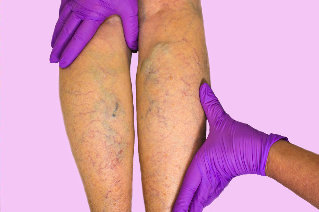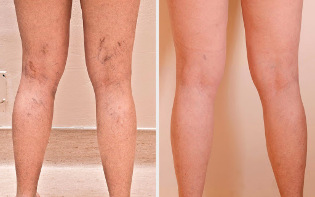It is a chronic venous disease, which is characterized by thinning of the walls, expansion of the cavity and the formation of nodes. Found 40% of women and 20% men.
This is a dangerous disease, mainly because of their complications. Wrong or delayed treatment develops as scary as thrombosis and thrombophlebitis, and bleeding varices. Thrombosis (partial or complete occlusion of the target vein by blood clot) or thrombophlebitis (inflammatory disease of the venous wall, thrombosis) occurs suddenly, is not associated with physical activity. The swelling rapidly spread to the lower extremities and is accompanied by unbearable pain. Can occur redness or bruising, local tenderness of the skin. In that case, that the separation of the clot of blood that will have blood vessels in the lungs, and in the case of full or partial closure of the vessel can cause serious illness - pulmonary embolism. This complication is often fatal. If you suspect that these complications, you should immediately take a horizontal position, lift the leg up phone contact emergency medical help. When trauma to the dilated vessels may experience heavy bleeding. In this case, the urgent need to put in the leg above the bleeding tourniquet (medical or improvised), enough to ensure that the bleeding has stopped, and urgently call an ambulance.
Thrombosis (partial or complete occlusion of the target vein by blood clot) or thrombophlebitis (inflammatory disease of the venous wall, thrombosis) occurs suddenly, is not associated with physical activity. The swelling rapidly spread to the lower extremities and is accompanied by unbearable pain. Can occur redness or bruising, local tenderness of the skin. In that case, that the separation of the clot of blood that will have blood vessels in the lungs, and in the case of full or partial closure of the vessel can cause serious illness - pulmonary embolism. This complication is often fatal. If you suspect that these complications, you should immediately take a horizontal position, lift the leg up phone contact emergency medical help. When trauma to the dilated vessels may experience heavy bleeding. In this case, the urgent need to put in the leg above the bleeding tourniquet (medical or improvised), enough to ensure that the bleeding has stopped, and urgently call an ambulance.
Weakness in the muscle layer of the venous wall and valvular incompetence be the cause, which affected the actions of the "muscle pump" the blood begins to flow in the opposite direction, downward. This leads to increased pressure on the walls of blood vessels, the progression of valve disease, enlargement of the lumen of blood vessels, and nodules. The muscle fibers of vein walls atrophy, disrupted nerve receptors, which regulate venous tone, which in turn further improves the manifestations of venous insufficiency. Risk factors for the development of the disease are: genetic predisposition, pregnancy, obesity, daily for a long time sitting or standing, activities related to lifting, systematic wearing tight clothes, corset, wrong diet, inadequate intake of fiber and vitamins violations of hormonal status.
Clinical symptoms
The main visible sign of varicose veins disease - saccular or cylindrical dilation of superficial veins. Varicose veins of the legs become branched, protruding above the surface of the skin of the feet and legs. Varices maximally expressed a hard or long workout. In the early stage of the disease concerned about the fatigue, feeling of heaviness in the legs, burning, mild swelling, the severity of which maximum after exercise. May experience temporary swelling, aching pain along the veins. Timely access to an expert, even in the early stages to prevent the development of disease. With the progression of the disease form of chronic venous insufficiency.
The diagnosis of varicose veins
The "gold" standard is considered to be diagnostic ultrasound of the veins of the lower extremities, which are determined by the affected areas of the veins. This principle is based on the anatomical classification of varicose veins manifestation of the changed vessel. For example, the defeat of the great saphenous vein above or below the knee, small saphenous vein. When questionable data non-invasive methods resorted to surgical methods of investigation, eg. venography (the injection of a contrast agent to assess the condition of the venous system).
The treatment of varicose veins
Non-surgical treatment of varicose veins of the lower limbs gives good results only in the opening stages of the disease, when skin symptoms are not strongly expressed and only moderately reduced work ability.
This is a surgical disease, complete cure is possible only after the surgical treatment:
- Phlebectomy - surgical removal of the varicose-expanded veins. The aim of the operation is to remove the abnormal discharge of blood by removing the main trunks of the great or small saphenous vein and ligation of communicating veins. There are several types of surgery. They are applicable almost always, even in difficult cases. When all of these methods remove part of the vein, which has affected and healthy segments of the veins are preserved. Vienna as if carefully peeled, not cut the fabric, which also reduces the surgical trauma. The same thing happens when you use the surgical technique, and in addition, this causes less bruising, because the cold reduces spasm of the bleeding.
- Sclerotherapy - an introduction to vein special substance (sclerosant) which causes "caking" of the vein wall, which cessation of blood flow through it. As a result, no abnormal discharge of blood, eliminates the cosmetic defect, such as the Vienna collapses and becomes invisible. Sclerotherapy is effective only when the expansion of the small branches of the main trunks, which restricts its application to high severity of the process. The advantage of sclerotherapy is the lack of scars, the need for hospitalization. After hardening of the veins a special rehabilitation is necessary.
- Laser coagulation - a method based on the destruction of the vein wall warm laser exposure, resulting in a "spike" in the venous cavity. Displayed only if the expansion of the veins are not more than 10 mm. The method involves anesthesia. Cosmetically advantageous, but after I took the exit requires that the early activation of the patient, and the long-term elastic compression.













































